 |
|
 |
Cooking
|
The Cooking area of a restaurant offers teen
workers an opportunity for developing cooking skills, while learning to
handle equipment, organize tasks, and use creativity. Teen workers in this
area may also be exposed to the following hazards:
|
|
 |
 |
|
Burns |
Potential Hazard
 |
Remember:
Child Labor Laws do not permit employees younger than 16
to cook, except at soda fountains, lunch counters, snack
bars, and cafeteria serving counters.
|
Burn injuries are common among teen employees in
restaurants. Teens who work as fry cooks are at special risk for
burn injuries. Factors such as inexperience and the pressure to
"keep up" during busy periods can lead to potential
accidents. Other hazards include exposure to:
- Hot oil, grease, and steam from hot surfaces, hot food
and beverages, and
equipment such as stoves, grills, steamers, and fryers. Deep fat fryers are the number one cause of burns.
|
 |
Possible Solutions
|
|
Employers have the primary
responsibility for protecting the safety and health of their
workers. Employees are responsible for following the safe work
practices of their employers.
|
Follow
all safety procedures and wear all protective equipment provided by your employer and be trained in the proper use of equipment, for example:
|
- Do wear long-sleeved cotton shirts and pants
when cooking. A clean, dry, properly worn apron or uniform can protect you from burns and
hot oil splashes.
-
Do not cook without wearing protective
clothing, even in hot temperatures or
environments.
|
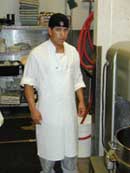 Proper length apron
Proper length apron
|
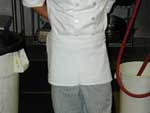
Shortened apron
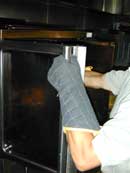
|
- Use appropriate hand
protection when hands are exposed to hazards such as cuts,
lacerations, and thermal burns. Use oven
mitts or pot holders when handling hot items, and steel mesh or
Kevlar gloves
when cutting.
|
| |
|
- Learn to use equipment and
personal protective equipment
properly and safely. For example, if cooking with steamers and pasta boilers:
- Use tongs and oven mitts to remove hot items from steamers or pasta boilers.
- Place hot steamed items on trays to
carry, rather than carrying steamed containers across the floor,
leaving a trail of dripping hot water that may cause
slips and falls.
- Open ovens or steamers by standing to the side, keeping the door between you and the open steamer.
- Open the top steamer first
when steamers are stacked, and then the lower one to prevent being burned from the rising steam.
|
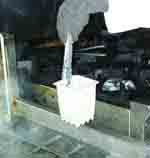
Pasta steamer
|
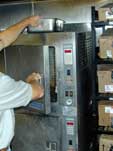
Don't reach above ovens or steamers while removing food.
|
- Do not stand above steaming items or equipment. Steam can burn.
- Do not reach above an oven or steamer. Hot air and steam rises and you could be burned.
- Do not open cookers and steam ovens when they are under pressure.
|
- Check hot foods on stoves or
in the microwave carefully. Uncover a container of steaming materials by lifting the lid open away from your face.
- Place sealed cooking pouches in
boiling water carefully to avoid splashing.
- Assume that pots, pot handles, and utensils in pots are hot and use oven mitts when handling them. Use long gloves for deep ovens.
- Adjust burner flames to cover only
the bottom of the pan. Avoid overcrowding on range tops.
- Wear sturdy footwear that is slip resistant
and not canvas or open-toed to protect the feet in case hot liquids are spilled on shoes.
- Ask for help when moving or
carrying a heavy pot of hot liquid off the burner.
|

Slip-resistant shoes |
|
- Do not allow pot handles or cooking utensils
to stick out from counters or stove fronts.
Keep pot handles away from burners.
- Avoid overfilling pots and pans.
- Do not clean vents over grill
areas if the grill is hot. Clean vents the next morning
before turning on for the day.
- Do not use metal containers,
foil, or utensils in a microwave oven.
- Do not pour or spill water or ice
into
oil, especially hot oil. It will cause splattering.
- Do not leave hot oil or grease
unattended.
- Do not use a wet cloth to lift lids from hot pots.
- Do not lean over pots of boiling liquid.
|
|
|
|
Employers have the primary
responsibility for protecting the safety and health of their
workers. Employees are responsible for following the safe work
practices of their employers.
-
Follow the
Fair Labor Standards Act
that forbids employees younger than 16 to cook, except at soda fountains, lunch counters, snack
bars, and cafeteria serving counters. State Child Labor Laws may
be more stringent.
-
Follow OSHA Standards including:
- Assess tasks to identify potential worksite
hazards and provide and ensure employee use of appropriate PPE. See
the Personal Protective Equipment (PPE) Standard [1910.132].
- Require employees to use appropriate hand
protection when hands are exposed to hazards such as cuts,
lacerations, and thermal burns. See the Hand Protection Standard [1910.138(a)].
|
Additional References
|
|
 |
|

